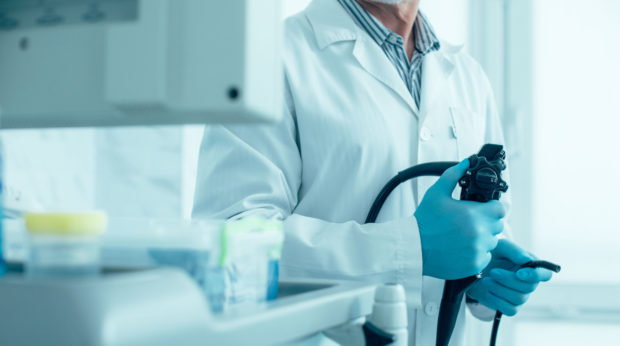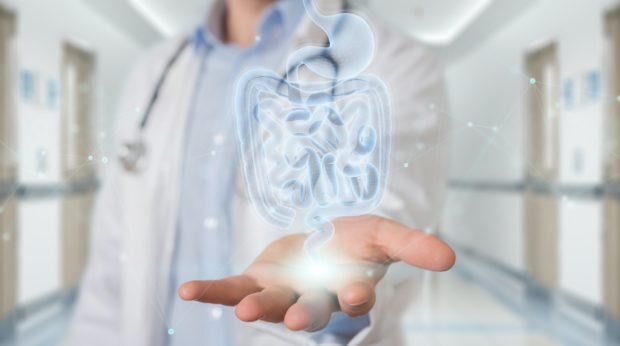Fecal calprotectin 1 (FC) is a protein found in leucocytes, and it appears in the intestinal mucosa when there is inflammation. It can be detected in the stool. If a patient’s test results show positive calprotectin, it means that there is intestinal inflammatory activity. This biomarker allows assessing that activity in an easy, fast and non-invasive way.
News
What does having positive calprotectin mean?
September 22, 2020
Patient

The FC varies its presence levels in the organism depending on the age. Newborns have elevated levels, but it decreases from the first week of life to the age of 5, when they are equal to those of an adult.
It is very useful to diagnose the inflammatory bowel disease (IBD), as well as to evaluate the response to the treatment and to see what course ulcerative colitis or Crohn’s disease take. As the positive calprotectin means that there is activity, the subsequent fall of it means the treatment is working well.
In order to detect fecal calprotectin, just take a stool sample and put it in a container. It is a normal collection that does not require any particular care. It is the same process as for a routine urine test; it is advisable to take the sample with the first deposition of the day. It can be stored for three days maximum before taking it to the corresponding specialist for it to be analyzed.
It is not recommended to administer treatments such as suppositories or enemas within 24 hours prior to the collection of the sample. Neither is to take anti-inflammatory drugs within the previous days. And lastly: if there is a scheduled colonoscopy, the collection cannot be done until three days after the test.
The increase 2 in calprotectin occurs three months before experiencing the disease again after an effective treatment. This can serve to foresee the risk, although, in some occasions, that increase just implies activity without symptoms.
Positive calprotectin: diagnose for an IBD
It is not completely effective to use the digestive symptoms as the only filter for the indication of a colonoscopy. Those are quite frequent and not specific whatsoever, because they are not exclusive signs of an inflammatory bowel disease.
Positive calprotectin may be a first test to identify an organic bowel disease before conducting a colonoscopy or a radiological study. This is very important in children, because avoiding a test like colonoscopy is best for them. In the case of short age patients experiencing persistent abdominal pain and sudden changes in their usual way of evacuating, it is almost certain that the positive calprotectin implies the presence of IBD. The use of this biomarker in the initial diagnosis of children could lead to an improvement in the referral to the endoscopic units.
It is common for doctors to find it difficult to differentiate between an irritable bowel syndrome (IBS) and an inflammatory bowel disease (IBD). That happens because sometimes symptoms are practically the same (diarrhea and abdominal pain) for IBS and IBD. Fecal calprotectin comes into play here, since its level is higher in IBD patients than in those suffering from IBS.
Positive calprotectin, valid to predict relapse
Fecal calprotectin (FC) is a protein found in leucocytes, and it appears in the intestinal mucosa when there is inflammation. It can be detected in the stool. If a patient’s test results show positive calprotectin, it means that there is intestinal inflammatory activity. This biomarker allows assessing that activity in an easy, fast and non-invasive way.
The FC varies its presence levels in the organism depending on the age. Newborns have elevated levels, but it decreases from the first week of life to the age of 5, when they are equal to those of an adult.
It is very useful to diagnose the inflammatory bowel disease (IBD), as well as to evaluate the response to the treatment and to see what course ulcerative colitis or Crohn’s disease take. As the positive calprotectin means that there is activity, the subsequent fall of it means the treatment is working well.
In order to detect fecal calprotectin, just take a stool sample and put it in a container. It is a normal collection that does not require any particular care. It is the same process as for a routine urine test; it is advisable to take the sample with the first deposition of the day. It can be stored for three days maximum before taking it to the corresponding specialist for it to be analyzed.
It is not recommended to administer treatments such as suppositories or enemas within 24 hours prior to the collection of the sample. Neither is to take anti-inflammatory drugs within the previous days. And lastly: if there is a scheduled colonoscopy, the collection cannot be done until three days after the test.
The increase in calprotectin occurs three months before experiencing the disease again after an effective treatment. This can serve to foresee the risk, although, in some occasions, that increase just implies activity without symptoms.
Positive calprotectin: diagnose for an IBD
It is not completely effective to use the digestive symptoms as the only filter for the indication of a colonoscopy. Those are quite frequent and not specific whatsoever, because they are not exclusive signs of an inflammatory bowel disease.
Positive calprotectin may be a first test to identify an organic bowel disease before conducting a colonoscopy or a radiological study. This is very important in children, because avoiding a test like colonoscopy is best for them. In the case of short age patients experiencing persistent abdominal pain and sudden changes in their usual way of evacuating, it is almost certain that the positive calprotectin implies the presence of IBD. The use of this biomarker in the initial diagnosis of children could lead to an improvement in the referral to the endoscopic units.
It is common for doctors to find it difficult to differentiate between an irritable bowel syndrome (IBS) and an inflammatory bowel disease (IBD). That happens because sometimes symptoms are practically the same (diarrhea and abdominal pain) for IBS and IBD. Fecal calprotectin comes into play here, since its level is higher in IBD patients than in those suffering from IBS.
Positive calprotectin, valid to predict relapse
Relapse means experiencing the disease again shortly after finishing the convalescence of the same disease. IBD is characterized by periods of activity remission, with corresponding relapses when the intestinal inflammation increases again. This situation is difficult to predict. It is usually done by monitoring the patient to explore symptoms, although this is not fully effective. The signs may appear after the inflammation of the mucosa; therefore, it does not serve to detect relapses. Fecal calprotectin is more sensitive to detect the risk of relapsing.
Calprotectin is an abundant protein in the organism that comes from leucocytes (white blood cells). That is, it is a substance produced in the immune system cells which helps the body fight off infections and diseases. When there is inflammation in the gastrointestinal (GI) tract, neutrophils move to the inflamed area and that is when they liberate the calprotectin. A posteriori, those proteins will be eliminated along with other residues as stool. The fecal, in the stool, concentration of calprotectin is about 6 times higher compared to the levels of it in blood.
The stool, when it is examined under the microscope in the laboratory, will show levels of positive calprotectin. As a general rule, high levels of calprotectin indicate bacterial or parasitic infections, colorectal cancer or certain diseases that cause intestinal inflammation, such as ulcerative colitis and Crohn’s disease. In those latter cases, the higher the calprotectin, the more severe the inflammation. However, fecal calprotectin does not indicate the location or the cause of the gastrointestinal inflammation. In order to determinate the cause, signs and symptoms of the inflammation a colonoscopy can be required.
Low levels of calprotectin indicate that the signs and symptoms are attributable to a different cause (non-inflammatory). That is the case for irritable bowel syndrome and viral infections. Precisely, it is common for doctors to find it difficult to differentiate between an irritable bowel syndrome (IBS) and an inflammatory bowel disease. That happens because sometimes symptoms are practically the same (diarrhea and abdominal pain) for both diseases. Fecal calprotectin comes into play here: this biomarker will show higher levels in IBD patients than in those suffering from IBS.
Positive calprotectin in the IBD monitoring
Those who join the growing tendency to base the treatment of inflammatory bowel disease on objective data, propose to identify biomarkers that allow selecting those patients who will benefit more from an endoscopic examination. The fecal calprotectin has been proposed here as a biomarker for the bowel inflammation. It allows differentiating the IBD, it has a better correlation with the degree of inflammation than clinical indices and serological markers, and could be useful for predicting mucosal healing and risk of relapse. Because, with the measurement of calprotectin in stool repeatedly, changes can be monitored at the intestinal level of a patient for a long period of time.
Relapsing means experiencing the disease again shortly after finishing the convalescence of it. IBD is characterized by periods of activity remission, with corresponding relapses when the inflammation increases again. This situation is difficult to predict. It is usually done with patient’s monitoring to explore symptoms, although this is not fully effective. The signs may appear after the inflammation of the mucosa; therefore, it does not serve to detect relapses.
The fecal calprotectin is said to be more useful to discover the risk of relapsing. Since, the increase1 in calprotectin occurs three months before experiencing the disease again after an effective treatment. This can serve to foresee the risk (although, in some occasions, this increase just implies activity without symptoms).
What is necessary for the realization of a fecal calprotectin?
In order to detect fecal calprotectin, just take a stool sample and put it in a container. The test can be reliably analyzed on a sample of less than 5 grams, although it is recommended for the collected sample to be larger. It is a normal collection that does not require any particular care. It is the same process as for a routine urine test; it is advisable to take the sample with the first deposition of the day. It can be stored for three days maximum before taking it to the corresponding specialist for it to be analyzed.
It is not recommended to administer treatments such as suppositories or enemas within 24 hours prior to the collection of the sample. Neither is to take anti-inflammatory drugs within the previous days. And lastly: if there is a scheduled colonoscopy, the collection cannot be done until three days after the test.
- https://www.educainflamatoria.com/calprotectina-fecal-colitis
- https://www.elsevier.com/es-es/connect/educacion-medica/niveles-de-calprotectina-fecal,-claves-para-el-diagnostico-y-tratamiento-de-la-eii-conclusiones-del-ii-elsevieraegtalks
- Faecal calprotectin | Testing & causes of high result (ibdrelief.com)
Contact UsFor more information
Contact Us

